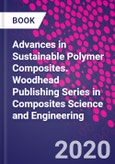Advances in Sustainable Polymer Composites reviews recent scientific findings on the production and use of sustainable polymers and composites as innovative new materials. The book discusses the importance of sustainable polymers in terms of current practices and how to address environmental and economic issues. Attention is focused on the physical, chemical and electrical properties of these composites. The book also looks at the lifecycle of both single and hybrid polymers and nanocomposites, with chapters covering the latest research findings on sustainable polymer composites with various filler loadings and their improvement on compatibility.
From the viewpoint of polymer composites, this book covers not only well-known sustainable future trends in sustainable polymers and composites, but also advanced materials produced from micro, nano and pico-scale fillers that achieve better physical and mechanical results.
Please Note: This is an On Demand product, delivery may take up to 11 working days after payment has been received.
Table of Contents
1 Importance of sustainable polymers for modern society anddevelopment 1
Rezaur Rahman, Nur-Azzah Afifah Binti Taib,
Muhammad Khusairy Bin Bakri and Siti Noor Linda bt Taib
1.1 Introduction 1
1.2 Current application of polymers 2
1.3 Waste production from the applications of polymers 13
1.4 Environmental effects of nonbiodegradable polymers 16
1.5 Current application of biodegradable polymers 18
1.6 Environmental effects of biodegradable polymers 25
1.7 Sustainability of polymers 26
1.8 Conclusion 29
References 31
2 Physical and chemical properties of sustainable polymers and
their blends 37
Md. Saiful Islam and Md. Moynul Islam
2.1 Introduction 37
2.2 Properties, modification techniques, and the application of
PLA and chitosan 38
2.3 Modifications process of PLA 39
2.4 Various blending 42
2.5 The effect of nanoparticles on blending composites 48
2.6 Conclusion 52
Acknowledgment 53
References 53
3 Sustainable reinforcers for polymer composites 59
Md. Saiful Islam and Md. Moynul Islam
3.1 Introduction 59
3.2 Natural fibers 61
3.3 Properties of natural fibers 71
3.4 Properties of natural fiber composites 71
3.5 Fiber processing 71
3.6 Chemical treatments 73
3.7 Effect of chemical treatments on natural fibers 76
3.8 Scanning electron microscopy 77
3.9 Tensile properties 78
3.10 Flexural properties 79
3.11 Impact properties 80
3.12 Applications 80
3.13 Future market trends 82
3.14 Summary 82
Acknowledgment 82
References 83
4 Sustainable resin systems for polymer composites 89
Faisal I. Chowdhury
4.1 Introduction 89
4.2 Hybrid resin composites 90
4.3 Flowable (low-viscosity) composite resin 91
4.4 Nanocomposite resins 93
4.5 Carbon nanocomposite resins 93
4.6 Metal oxide nanocomposite resins 96
4.7 Natural fiber
4.8 Self-healing composite resins 99
4.9 Antimicrobial composite resins 102
4.10 3D printable antimicrobial composite resins 103
4.11 Stimuli-responsive composite resins 103
References 105
5 Use of sustainable polymers to make green composites 109
Muhammad Khusairy Bin Bakri, Md Rezaur Rahman,
Perry Law Nyuk Khui, Elammaran Jayamani and Afrasyab Khan
5.1 Introduction of polymers 109
5.2 Types of polymers 110
5.3 Characterization and testing method based on standards 114
5.4 Composites manufacturing process 123
5.5 Summary 124
References 124
6 Electrical properties in reinforced polymer composites 131
Perry Law Nyuk Khui, Md. Rezaur Rahman, Elammaran Jayamani,
Muhammad Khusairy Bin Bakri and Afrasyab Khan
6.1 Introduction 131
6.2 Utilization of fillers in polymer composites (electrical conductivity) 132
6.3 Hybrid fillers in polymer composites (electrical conductivity) 132
6.4 Dielectrical properties of polymer composites 133
6.5 Resistivity of polymer composites 135
6.6 Applications of polymer composites in electrical and electronic
industry 136
6.7 Summary 137
References 138
7 Rheological behavior and transport of molten polymers and
gas
Khairuddin Sanaullah and Afrasyab Khan
7.1 Introduction 141
7.2 Flow properties of polymer liquids 142
7.3 Transport equations of molten polymer flows 149
7.4 Multiphase flows 156
Appendix A Derivation of Hagen
flow 174
Appendix B One-dimensional momentum equation for gas Newtonian
liquid two-phase flow for separated flow regime 176
References 179
8 Applications of sustainable polymer composites in automobile and
aerospace industry 185
Adamu Muhammad, Md Rezaur Rahman, Rubiyah bt Hj Baini and
Muhammad Khusairy Bin Bakri
8.1 Introduction 185
8.2 Automobile industry 187
8.3 Aerospace industry 195
8.4 Challenges of implementing sustainable polymer composites for
automobiles and aircrafts 200
8.5 Conclusion 201
References 201
9 Hybrid sustainable polymer composites 209
Sweety Shahinur and Mahbub Hasan
9.1 Introduction 209
9.2 Hybrid composite 211
9.3 Sustainability of polymer composite 216
9.4 Case study 224
9.5 Summary and concluding remarks 224
References 226
10 Nano-reinforcement in sustainable polymer composites 231
Muhammad Khusairy Bin Bakri, Md. Rezaur Rahman,
Siti Noor Linda Taib, Perry Law Nyuk Khui, Akshay Kakar and
Elammaran Jayamani
10.1 Introduction 231
10.2 Types of nonrenewable nano-reinforcements 232
10.3 Types of renewable nano-reinforcements 237
10.4 Applications of nano-reinforced polymer composites 238
10.5 Summary 239
References 239
11 Life cycle assessment of sustainable composites 245
Elammaran Jayamani, Tee Jun Jie and Muhammad Khusairy Bin Bakri
11.1 Composite materials 245
11.2 Characteristic of composite material 245
11.3 Characteristic of composite material 245
11.4 Importance of composite material in aerospace industry 246
11.5 Current application of synthetic fiber polymer composite in
aerospace industry 247
11.6 Current application of natural fiber polymer composites in
aerospace industry 248
11.7 Life cycle assessment 249
11.8 Application of life cycle assessment in aviation industry 252
11.9 Methodology 252
11.10 Result and discussion 256
11.11 Conclusion 263
References 264
12 Recycling of sustainable polymers and composites 267
Perry Law Nyuk Khui, Md. Rezaur Rahman, Elammaran Jayamani and
Muhammad Khusairy Bin Bakri
12.1 Introduction 267
12.2 Sustainable polymers 268
12.3 Recycling thermoplastic polymers and composites 269
12.4 Recycling thermoset polymers and composites 270
12.5 Primary recycling 271
12.6 Mechanical recycling 272
12.7 Chemical recycling 272
12.8 Challenges of recycling polymers and composites 275
12.9 Summary 277
References 277
Index 283








